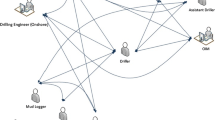Abstract
The current study was undertaken to inform the development of simulations for improving train driver’s decision making under degraded track conditions. Trains are sophisticated heavy machinery and their performance is ever increasing resulting in the driving task becoming more complex and progressively dominated by cognitive and perceptual skills. A critical part of reducing the potential for train driver error and of increasing performance lies in the appropriate design of simulation training. In the current study a cognitive task analysis, using the critical decision method (CDM) was undertaken using a focus group research design. The process resulted in increased knowledge of expert train driver decision-making processes. Across four major incidents analyzed 11 decision points, 17 cues, 30 essential responsive actions and 45 possible errors where identified. The use of these results for supporting the design of simulation training and associated performance measures is discussed.
Similar content being viewed by others
References
Andews DH, Bell HH (2000) Simulation-based training. In: Tobias S, Fletcher JD (eds) Training and retraining: a handbook for business, industry, government, and the military. Macmillan, New York, pp 357–384
Baker DP, Gustafson S, Beaubien J, Salas E, Barach P (2005) Medical teamwork and patient safety: the evidence-based relation, AHRQ Publication No.05-0053. Agency for Healthcare Research & Quality, Rockville
Cannon-Bowers JA, Salas E (1998a) Making decisions under stress: implications for individual and team training. American Psychological Association, Washington
Cannon-Bowers JA, Salas E (1998b) Individual and team decision making under stress: theoretical underpinnings. In: Cannon-Bowers JA, Salas E (eds) Making decisions under stress: implications for individual and team training. American Psychological Association, Washington, pp 17–38
Cannon-Bowers JA, Burns JJ, Salas E, Pruitt JS (1998) Advanced technology in scenario-based training. In: Cannon-Bowers JA, Salas E (eds) Making decisions under stress: implications for individual and team training. American Psychological Association, Washington, pp 365–374
Driskell JE, Johnston JH (1998) Stress exposure training. In: Cannon-Bowers JA, Salas E (eds) Making decisions under stress: implications for individual and team training. American Psychological Association, Washington, pp 191–217
Fowlkes JE, Salas E, Baker DP, Cannon-Bowers JA, Stout RE (2000) The utility of event-based knowledge elicitation. Human Factors 42:24
Hall S (1999) Hidden dangers: railway safety in the era of privatization. Ian Allen, Shepperton
Hoffman RR, Crandall B, Shadbolt N (1998) Use of the critical decision method to elicit expert knowledge: a case study in the methodology of cognitive task analysis. Human Factors 40:254–277
Klein GA, Calderwood R, MacGregor D (1989) Critical decision method for eliciting knowledge. IEEE Trans Syst Man Cybern 19:462–472
Li G, Hamilton I, Morrisroe G, Clarke T (2006) Driver detection and recognition of lineside signals and signs at different approach speeds. Cogn Technol Work 8:30–40
Lipshitz R, Klein G, Orasanu J, Salas E (2000.) Taking stock of naturalistic decision making. J Behav Decis Mak 14:331–352
Luke T, Brook-Crater N, Pares AM, Grimes E, Mills A (2006) An investigation of train driver visual strategies. Cogn Technol Work 8:15–29
McInerney PA (2005) Special commission of inquiry into the waterfall rail accident. Final report
McLeod RW, Walker G, Moray N, Love G (2003) Project summary report: driver reliability with extended AWS. Nickleby HFE Ltd, B/C271/FD.5
McLeod RW, Walker GH, Moray N (2005) Analysing and modeling train driver performance. Appl Ergon 36:671–680
McNaughton A (2003) Opening address. In: First European conference on rail human factors, New York
Militello LG, Hutton RJB (1998) Applied cognitive task analysis (ACTA): a practitioner’s toolkit for understanding cognitive task demands. Ergonomics 41:1618–1641
O’Hare D, Wiggins M, Williams A, Wong W (1998) Cognitive task analyses for decision centered design and training. Ergonomics 41:1698–1718
Olsson E, Jansson A (2005) Participatory design with train drivers: a process analysis. Interact Comput 17:147–166
Peterson B, Stine JL, Darken RP (2004) Eliciting knowledge from military ground navigators. In: Montgomery H, Lipshitz R, Brehmer B (eds) How Professionals Make Decisions. Lawrence Erlbaum, Mahwah
Roach GD, Dorrian J, Fletcher A, Dawson D (2001) Comparing the effects of fatigue and alcohol consumption on locomotive engineer’s performance in a rail simulator. J Human Ergol 30:125–130
Salas E, Oser RL, Cannon-Bowers JA, Daskarolis E (1999) Team training in virtual environments. In: Stanney KM (eds) Handbook of virtual environments. Lawrence Erlbaum, Mahwah, pp 873–892
Simmons-Boardman Publishing Corporation (2004) Simulating can be stimulating: virtual reality is the next best thing to putting a trainee train driver on the track. Int Railway J 44:41–43
Tichon J, Hall RH, Hilgers MG, Leu MC, Agarwal A (2003) Education and training in virtual environments for disaster management. In: Proceedings of World conference on educational multimedia, hypermedia and telecommunications. Honolulu, pp 1191–1194
Wilson JR, Norris BJ (2006) Human factors in support of a successful railway: a review. Cogn Technol Work 8:4–14
Wong W (2005) The integrated decision model in emergency dispatch management and its implications for design. Austral J Inform Syst 2:95–107
Zakay D, Wooler S (1984) Time pressure, training and decision effectiveness. Ergonomics 27:273–284
Acknowledgments
The financial support of Railcorp and the Australian Research Council is gratefully acknowledged.
Author information
Authors and Affiliations
Corresponding author
Rights and permissions
About this article
Cite this article
Tichon, J.G. The use of expert knowledge in the development of simulations for train driver training. Cogn Tech Work 9, 177–187 (2007). https://doi.org/10.1007/s10111-006-0048-6
Received:
Accepted:
Published:
Issue Date:
DOI: https://doi.org/10.1007/s10111-006-0048-6




